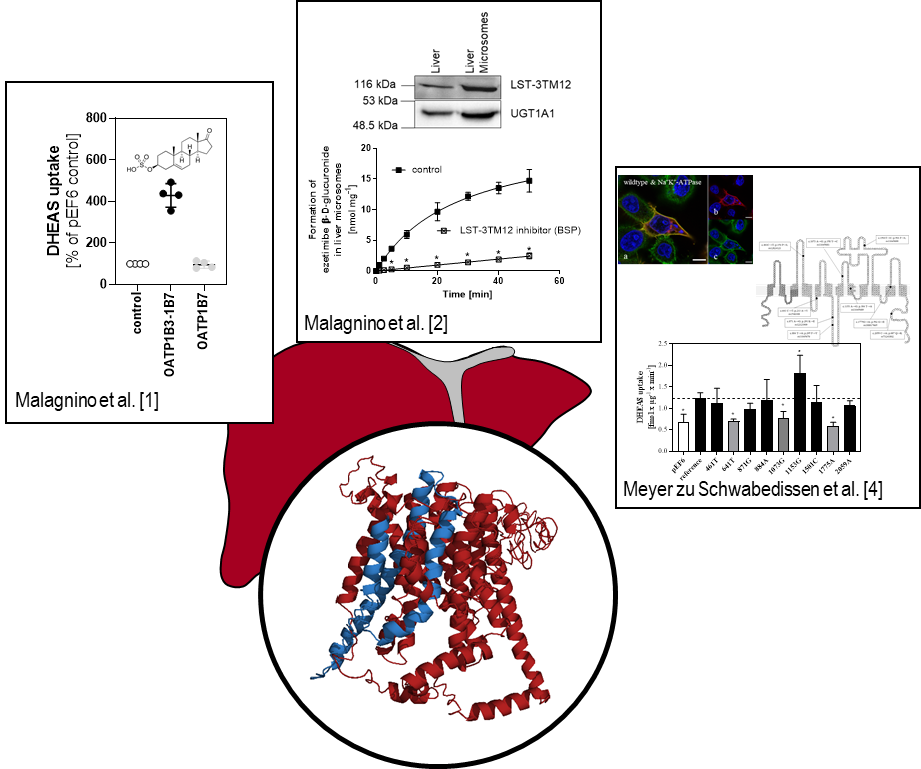Identification and characterization of OATP1B3-1B7 (formerly LST-3TM12) as novel functional member of the OATP1B-subfamily
Organic anion transporting polypeptides (OATPs) are membrane proteins facilitating the cellular entry of their substrates. It is widely accepted that members of this family of SLCs (solute carriers) are determinants of pharmacokinetics. Especially OATP1B3 and OATP1B1, which are highly abundant in liver, have been focus of studies in pharmacology in the last decades. These studies revealed their prominent role in hepatic drug metabolism and finally resulted in the recommendation to test new molecular entities for interaction with OATP1B1 and OATP1B3 during the process of drug development.
However, inspecting the chromosomal region encoding for OATP1B3 and OATP1B1 we learned that there is an additional gene locus named SLCO1B7. Even if originally designated a pseudogene, there was a mRNA linked to this particular gene region (https://www.ncbi.nlm.nih.gov/nuccore/AY257470, also named LST-3TM12). Testing for expression and function of this particular mRNA sequence, we were able to show that OATP1B3-1B7 (https://www.ncbi.nlm.nih.gov/nuccore/NM_001371097.1) is expressed in liver, where it is located in the smooth endoplasmatic reticulum (SER) of hepatocytes. In transport studies conducted in HeLa cells transiently transfected with plasmids encoding for OATP1B3-1B7 we identified dehydroepiandrosterone sulfate (DHEAS) as a substrate [1]. Further studies on OATP1B3-1B7 revealed its role in the glucuronidation of ezetimibe [2]. In the metabolism of ezetimibe, the transporter most likely modifies accessibility to the active site of UGTs within the lumen of the SER. Besides its role in drug metabolism, we were able to show regulation by the farnesoid X receptor (FXR), which links the transporter to the gene network involved in bile acid homeostasis [3]. During cloning of the transporter for our first functional studies [1] we observed two genetic variants, namely rs12321909 (c.871G; p.291E) and rs73241802 (c.2059A; p.687K), which are both non-synonymous. We selected further non-synonymous polymorphisms reported in the SNP database (www.ncbi.nlm.nih.gov/snp/) and tested all polymorphisms for the minor allele frequency in a Caucasian population and their functional influence. For the variants OATP1B3−1B7 641T (rs1546308), 1775A (rs188817665), and 1073G (rs11045681) we observed changes in in vitro transport function, which were neither explained by changes in protein amount or sorting.
With the identification of non/reduced function alleles, we provided a tool for pharmacogenetic studies, that may help to further investigate the role of the transporter in pharmacology and physiology.

[1] LST-3TM12 is a member of the OATP1B family and a functional transporter. Malagnino V, Hussner J, Seibert I, Stolzenburg A, Sager CP, Meyer zu Schwabedissen HE. Biochem Pharmacol. 2018;148:75-87. doi: 10.1016/j.bcp.2017.12.012 (https://www.ncbi.nlm.nih.gov/pubmed/29248594)
[2] OATP1B3-1B7 (LST-3TM12) Is a Drug Transporter That Affects Endoplasmic Reticulum Access and the Metabolism of Ezetimibe. Malagnino V, Duthaler U, Seibert I, Krähenbühl S, Meyer zu Schwabedissen HE. Mol Pharmacol. 2019;96(2):128-137. doi: 10.1124/mol.118.114934 (https://www.ncbi.nlm.nih.gov/pubmed/31127008)
[3] OATP1B3-1B7, a novel organic anion transporting polypeptide, is modulated by FXR ligands and transports bile acids. Malagnino V, Hussner J, Issa A, Midzic A, Meyer zu Schwabedissen HE. Am J Physiol Gastrointest Liver Physiol. 2019;317(6):G751-G762. doi: 10.1152/ajpgi.00330.2018 (https://www.ncbi.nlm.nih.gov/pubmed/31509437)
[4] Genetic variants of SLCO1B7 are of relevance for the transport function of OATP1B3-1B7. Meyer zu Schwabedissen HE, Seibert I, Grube M, Alter CL, Siegmund W, Hussner J. Pharmacol Res. 2020 Aug 18;161:105155. doi: 10.1016/j.phrs.2020.105155 (https://pubmed.ncbi.nlm.nih.gov/32818652)
